Results 151 to 160 of 185
Thread: Learning Jnats with Microscope
-
06-11-2021, 05:31 PM #151Senior Member



- Join Date
- Apr 2012
- Location
- Diamond Bar, CA
- Posts
- 6,553
Thanked: 3215
The Heljestrand edge may be improved a bit.
With razors that I know are hard and have some edge damage, like yours I begin by jointing the edge straight.
Here I look down on the edge, any dark spots are where pitting or chipping still exist. The goal is to remove all the chipping and get to good steel and straight, flat edge. It may take a couple extra jointing.
Then reset the bevel on a lower grit synthetic stone 4-6k, your 3k should be fine. Once you have fully reset the bevel, joint the edge again to remove the rough weak edge from the synthetic and reset the edge on Tsushima slurry, replace the slurry as needed, as it darkens and fills with steel until you get a stria free bevel and straight edge.
Remove the edge and reset on a finer Nagura.
With hard steel removing and resetting the edge ensures that your edge is of solid steel and chip free, making the best, strongest edge possible. The extra effort takes but a few minutes and pays large dividends.
Some old Swedish steel is very hard and combined with a shoulder less grind you must watch you pressure. Especially with a thin bevel it is easy to apply too much pressure and lift the edge off the hone, maybe not enough to completely lift the edge, but enough to not make full contact at the edge.
It is another reason that micro bevels (added layer of Kapton) work very well on hard steel razors. Practice with the micro bevels, there are great edges in micro bevels and can be a great solution for stubborn edges.
Thin tape and 2-5 laps can make all the difference, you want a micro bevel not double bevel.
-
The Following User Says Thank You to Euclid440 For This Useful Post:
Skorpio58 (06-12-2021)
-
06-12-2021, 09:15 AM #152
 How Teaching should always be!
How Teaching should always be!
Euclid,
Your previous two posts are two monuments to what teaching should always be. There are, condensed together, knoweldge sharing, support, guidance, and suggestions as well as concepts of a psychological approach on how to face a path of continuous improvement.
How else could I have correctly assessed what is with what "should" be, without having such a reference guide? As a beginner, I could not know if and how much a stone could/should be performing. As you yourself said: "I am always amazed at what people will shave with and accept". Here, I would have seriously run the risk of settling for little ... because I did not know that much more could be achieved.
And all this ... not only helps me to grow and improve always ... but it can also help the many who read now and will read this thread in the future!
Regarding Heljestrand, before putting your suggestions into action, I want to see how it behaves in the next two/three shaves, to realize how much/how the edge holds now, and how it will perform after the "treatment" you suggest.I know that I don't know (Socrates)
-
The Following User Says Thank You to Skorpio58 For This Useful Post:
Euclid440 (06-12-2021)
-
06-23-2021, 09:41 AM #153
 Quick Updates.
Quick Updates.
Last week I met some friends @ the monthly Rome's "honing" meeting, so I had the opportunity to test something "new" (apart for the Gujo Nagura which got home recently).
1) I used "live" another (affordable) microscope, with included 7" screen, and it was waaaaaaaaay better than mine. Better when working and better in image quality to share here. (Image of this post made with a smartphone... not the ones I'll share in the future from the sd card). So it's now on my wishlist.
2) Tested the legendary "Water of Ayr" scottish stone. I finished on it the razor (lasso Solingen) previously finished on Llyn Idwall (see the post HERE)
Was really impressed with the results. The day after shave was one of the smoothest ever.
Next step will be getting the new microscope and starting to test the Gujo Nagura (first impressions are good) comparing it to Tsushima on my base stones.
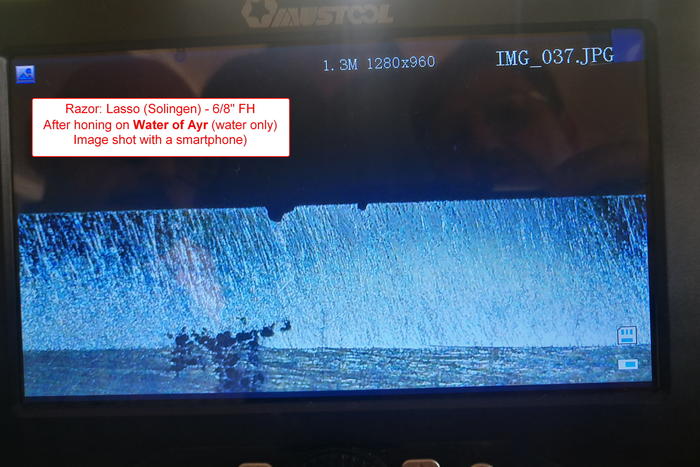 I know that I don't know (Socrates)
I know that I don't know (Socrates)
-
06-23-2021, 11:41 AM #154Senior Member

- Join Date
- Sep 2018
- Location
- Palm Harbor Fl
- Posts
- 373
Thanked: 49
I used to use a scope. And for many years a 10x lighted loupe. Lately? I don't even use the loupe. I judge the edge by the feedback I get from known stones. I avoid the issues that can damage an edge. I have several tomos that are very hard and dont drop boulders on the finisher. My typical progression is 1k chosera to midrange with atoma slurry. And then one tomo or atoma slurry. Sometimes I spray the slurry off the midrange and use that on my finisher. I never get that crunchy feeling using the tomos, stones and atoma plate I have. But if your testing stones and methods visual is important. As well as detecting the crunch from a stray particle. And of course edge damage by pitting etc is essential. I'm not criticizing any method or tool now. Use what you like of course. But I hone for utility. And the fastest easiest path that delivers what I want( I'm very fussy about what I shave with) is what I will gladly continue to do.
-
06-23-2021, 05:40 PM #155Senior Member



- Join Date
- Apr 2012
- Location
- Diamond Bar, CA
- Posts
- 6,553
Thanked: 3215
The Gujo nagura may be interesting, but it sounds like they can vary a bit in performance.
Being that they are low grit stones, it really should not matter all that much. They are much like a 1k stone, hey just hog off material, all 1k’s do the same thing, remove metal, and leave 1k stria.
They may be a bit softer, more aggressive or polish more, but it is the bottom of the nagura progression, and it is the rest of the progression that makes the difference if the bevel is flat and stria free.
I like the Tsushima over the Botan because it is fast but breaks down to a finer slurry and polishes a bit more than Botan. Just a bit, but it allows me to see if all synthetic stria is removed and leaves a nice even finish for the next nagura to refine further.
Could I do the same with Botan, probably. But I have a stable of my favorite nagura, Tsushima, Tenjyo and a hard Tomo Asagi that works very well with most of my stones. Some I finish on Koma.
Not to say it does not all make a difference, but after the transition to Jnat slurry Botan, Tsushima or Gujo all do the same. It is learning the stones that you have with the base stones and razors and how you can tweak each to maximize each for the goal, the edge.
The scope photos look interesting, what are the black spots on both ends of the bevel, is that sharpie or light reflection?
-
The Following User Says Thank You to Euclid440 For This Useful Post:
Skorpio58 (06-24-2021)
-
06-23-2021, 05:58 PM #156

Bill31521
You're right of course, but you said: "for many years"... So, you're an experienced user, while I'm a newbie (just one year shaving with straight razors and less, 9/10 months honing). I needed (and still need) to understand what I'm doing and see how different stones/steels behave when honing.
Due precisely to that path of experiences, both visual and practical, I am actually able, with a good success rate, to hone razors without geometry problems even without using the microscope, and I am also able to recommend (with a reasonable chance of success) to my friends to use a specific pairing among my stones base/Nagura (for example Nakayama Kiita/Ozuku Suita) ... as I did last Saturday. In fact, a friend of mine (not satisfied by the finish of his Nakayama on a Puma Razor) used the combination I suggested and found himself so well (both as microscopic images and while shaving), he asked me if it was possible to find another Nagura like mine ... I know that I don't know (Socrates)
I know that I don't know (Socrates)
-
06-24-2021, 09:26 AM #157

Euclid,
Well, I heard wonders about Gujo from a man here in Italy who helds a YouTube Channel dedicated to honing. He's in love expecially with Jnats and is a good source of information about these stones. I'm on Jnats really because of him! He says it can easily go from 1k directly to a finishing Nagura. So I wanted to check whit my eyes and skin how the Gujo performs. Also since it is very cheap!
He says it can easily go from 1k directly to a finishing Nagura. So I wanted to check whit my eyes and skin how the Gujo performs. Also since it is very cheap!
Made a screenshots with the smartphone on a razor of another guy I honed (on my Ozuku Asagi Koppa) during last saturday's meeting (then I finished it with my Ozuku Suita Tomo). The razor had lot of rust on the bevel before Gujo, and it's slurry fully removed it, leaving a quite straight edge. Nothing a Tsushima couldn't do... of course!
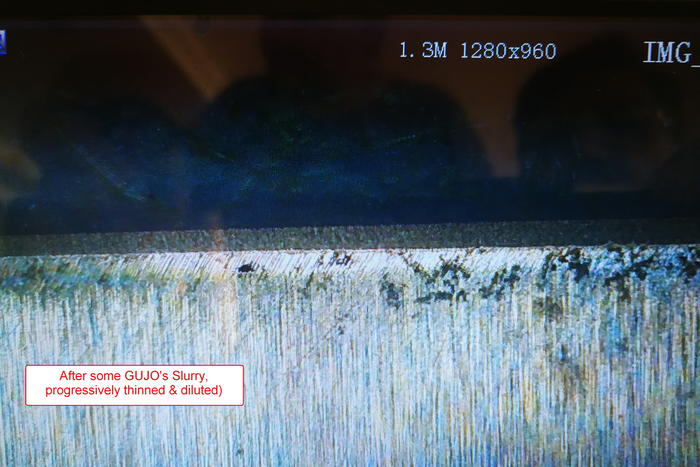
The black spots in previous post's microscope image are reflections on polished (I used the Water of Ayr stone water only) steel.Last edited by Skorpio58; 06-24-2021 at 09:58 AM.
I know that I don't know (Socrates)
-
06-28-2021, 10:35 AM #158
 Honing for a friend. First Gujo Nagura test.
Honing for a friend. First Gujo Nagura test.
As in my last posts, I've got a Gujo, to be added to my already ample arsenal of Nagura.

After a quick test during the recent honing meeting, I decided to use it as a starter in my usual honing sequence and see what will happen.
Had to hone a Tridente (Solingen - 6/8" FH) razor for a friend. I refreshed it's edge on my Nakayama some months ago, but didn't had a microscope and don't remember if I used a shobudani tomo or diamond plate to raise the slurry. Being the owner an occasional user of straight razors, didn't heard from him after the first shave (he said it was good) so, when I met him @ the meeting, gave a look to the bevel with microscope because, according to him, the razor currently sticks and tears, especially on ATG pass.
You can see the bevel/edge conditions in first image: a veeeery narrow bevel, a not so straight edge and some micro-chips. Btw. the reference point showed in images IS NOT the narrower part of the bevel! Anyway, treetop test was positive.
Anyway, treetop test was positive.
As Euclid440 pointed out, the Gujo is a quite coarse nagura. However, working the slurry, the particulate gradually tends to refine itself (and therefore, it can reach a level of pre-finishing of the bevel). In short, it can act as a kind of Botan + Tenyou. On this occasion, I kept more on the "coarse" side and didn't work too much (neither diluted or thinned) the slurry. The rest of the sequence took place as usual: Tsushima, Asano Mejiro and Ozuku Suita. Used my Ozuku Asagi as a base stone. Used one layer of Kapton tape too.
Microscopic results seems quite good. Gujo immediately straightened and gave a better aspect to the edge/bevel, and the other naguras made, as usual, their homework. Its interesting to see how the bevel enlarged a bit, as the sequence progressed (expecially after the last nagura). I think it is due to the progressive decrease of the (torsional) pressure I used, moving towards the finishing phase.
However, these are very small differences, visible only thanks to the considerable magnification. In fact, the bevel remained very narrow during normal observation.
The razor easily passed the treetop test.
As for shaving results, I will have to wait about a week before I hear from my friend. Of course, I'll publish an update post.


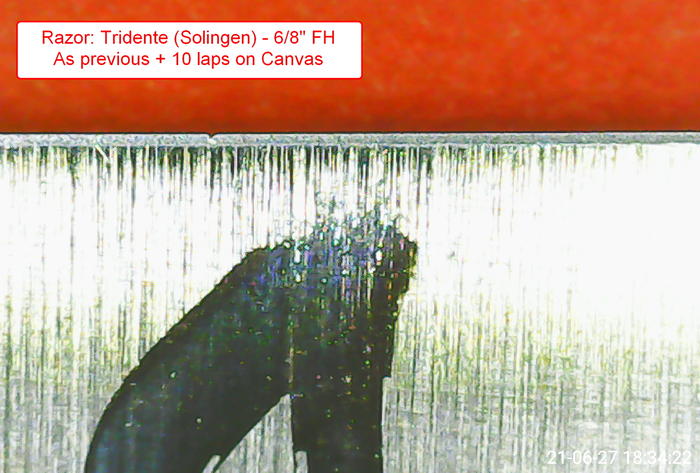
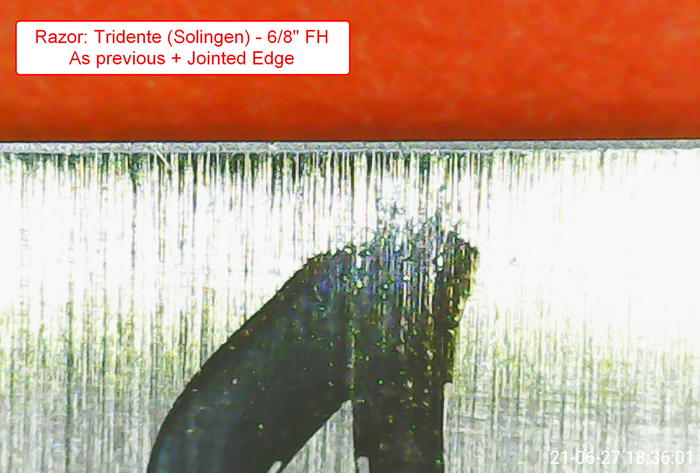
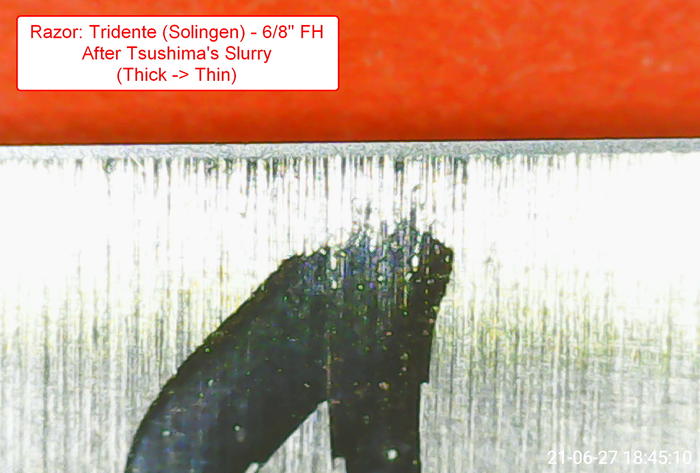
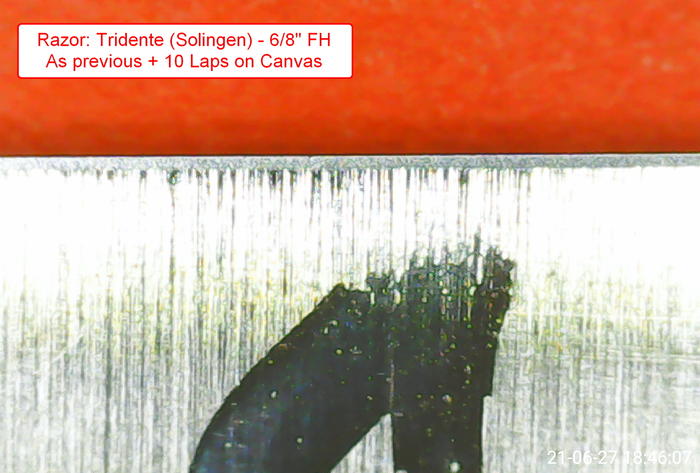
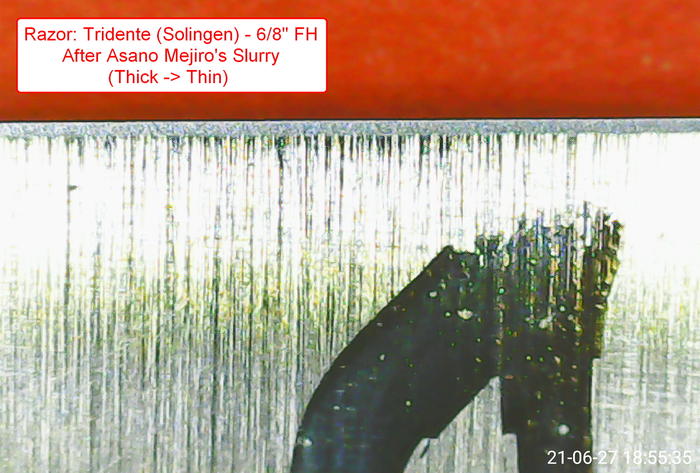
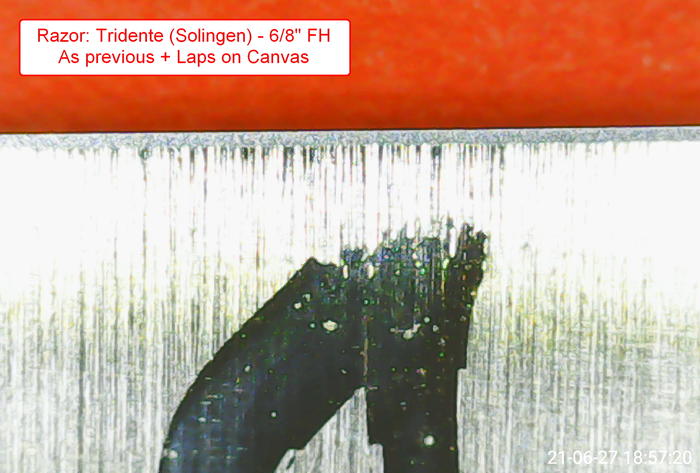
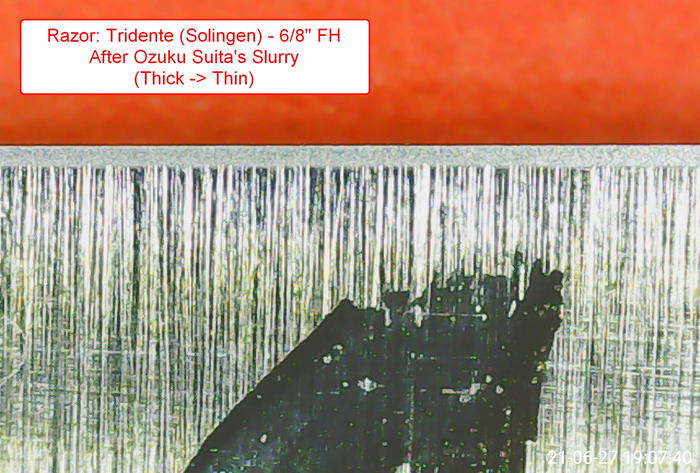

Last edited by Skorpio58; 06-28-2021 at 10:39 AM.
I know that I don't know (Socrates)
-
06-28-2021, 12:47 PM #159Senior Member



- Join Date
- Apr 2012
- Location
- Diamond Bar, CA
- Posts
- 6,553
Thanked: 3215
Is the bevel equally narrow from heel to toe and on both sides? A very narrow bevel can be a result of a heel issue or warp in the blade. If heel, it must be corrected before honing. If a warp, the razor must be honed to compensate for the warp. Most razors with stabilizers need some heel correction, it should be a part of every honing.
When honing a new/different razor, first inspect the razor, check the razor for straightness. Lay on a flat surface to check for warp or twist, also inspect the heel to ensure the heel corner of the edge is at least a ¼ inch from the stabilizer. That the razor is flat is not the issue, few are perfectly flat, but it will tell you how to hone the razor. You cannot hone every razor the same way.
Or it could have a geometry issue, rare.
The condition of the bevel after a couple month of use indicates a problem with the strop or stropping. Most likely a dirty strop.
Because of the edge damage, I would have removed more of the edge, jointing several times to remove all the chips and ensure good steel. Remove all the chips with your lowest grit, before moving up. All steel at the edge must be removed to the lowest point of the chip before you start to build a new edge, or the edge will micro chip after a few stropping.
Stay on the Tsushima until all the deep random stria is removed and the edge is straight, joint and re-set as needed.
Not too sure the bevel got much larger, looks like your scope got closer in the final photos.
Ended up with a nice bevel and straight edge.
-
06-29-2021, 11:44 AM #160

Euclid,
Yes... I admit, I didn't thoroughly check the razor before sharpening it.
But in reality, it rested well on the stone and, by controlling the movement of the slurry during the passes, there were no obvious problems. We also take into account that the differences in the width of the bevel were minimal and "played" on a very small order of magnitude: i.e. fractions of tenths of a millimeter. However, looking back at the bevel in retrospect, if there was a problem, I think it may be due to the toe rather than a warped blade, as there, the bevel is slightly wider and a bit too close to the stabilizer.
Regarding the 2 or 3 micro-chips on the edge, they were due to an incorrect closure of the blade on the scales, rather than to damaged steel. That's why I jointed it just a couple of times (Before Gujo & Tsushima).I know that I don't know (Socrates)


 211Likes
211Likes LinkBack URL
LinkBack URL About LinkBacks
About LinkBacks






 Reply With Quote
Reply With Quote
